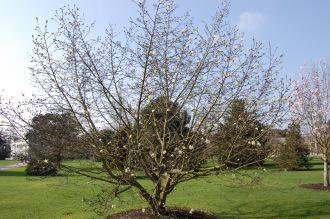
Magnolia 'Kewensis' Flower (11/03/2012, Kew, London)
Position: Full sun in a sheltered position
Flowering period: Spring
Soil: Moist, well drained
Eventual Height: 12m
Eventual Spread: 9m
Hardiness: 5a – 9a
Family: Magnoliaceae
Magnolia ‘Kewensis’ is a slow growing, deciduous, rounded large shrub/ small tree. Its mid green leaves are simple, ovate to obovate with entire margins and opposite. Its bark is an attractive gray color. Its fragrant white flowers are stellate shaped and arranged solitarily. Its fruit is green in color and they appear as follicles.
Magnolia ‘Kewensis’, commonly known as Kew Magnolia, is a hybrid between Magnolia kobus and Magnolia salicifolia. It has been recorded in the wild where these two species intersect in their native Japan. Magnolia ‘Kewensis’ is synonymous with Magnolia x Kewensis.
The etymological root of the binomial name Magnolia was named after Pierre Magnol, a 17th century French botanist. Kewensis means ‘of or from Kew Gardens, UK’, from where it was formally created.

Magnolia 'Kewensis' (11/03/2012, Kew, London)
The landscape architect may find Magnolia ‘Kewensis’ useful as a spring flowering specimen large shrub/ small tree. It should be sheltered from strong winds and late frosts, where possible.
Ecologically, M. ‘Kewensis’ is attractive to bees and pollinating insects.
The Royal Horticultural Society has given the variety M. x kewensis ‘Wada’s Memory’ their prestigious Award of Garden Merit in 1993.
M. ‘Kewensis’ prefers moist, fertile, well-drained soils. It tolerates most pH of soil, although it dislikes chalk soils
M. ‘Kewensis’ requires little maintenance. If pruning is required it should be carried out in mid summer.

